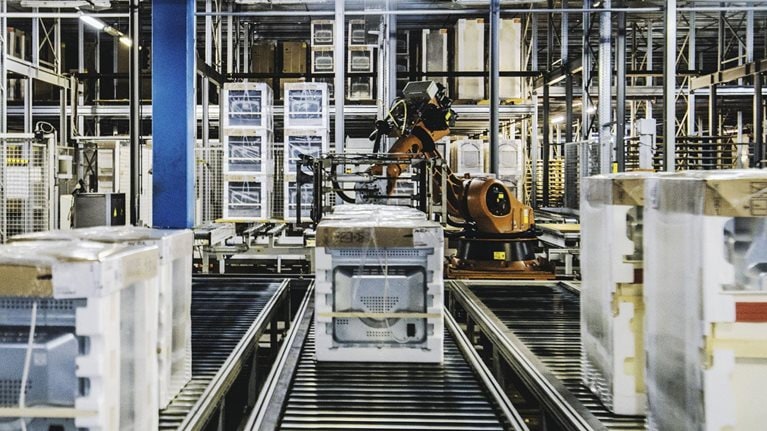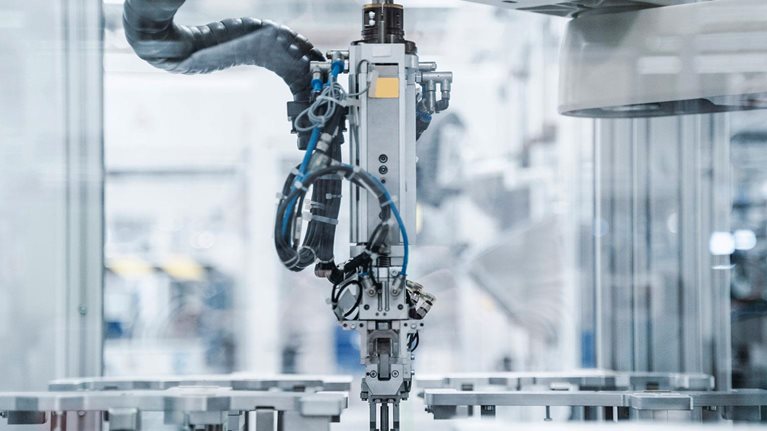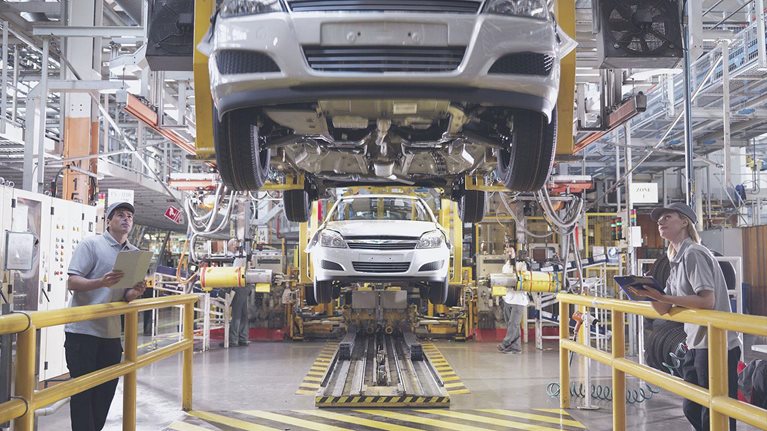Machinery and automation companies serve every industry, from consumer goods to high tech, and the equipment that rolls off their production lines is as varied and unique as their customers. But almost every business in this fragmented and diverse sector has seen demand drop and plants idle as the coronavirus spreads worldwide. Despite their fundamental differences, machinery and automation companies now share one goal: surviving the crisis and emerging stronger into the next normal.
While most companies have already addressed immediate concerns, including worker safety, few have yet created a complete plan to govern their eventual ramp-up to full production. To assist them, we reviewed the current state of the machinery and automation sector and created scenarios to model how demand might evolve across diverse customer segments. With this information, machinery and equipment providers can estimate how demand for their own products might evolve, as well as the timing and pace of their recovery. In addition to looking at global trends, we also examined the European market because it is the location of many machinery and automation companies, as well as many equipment customers. We then created a recovery framework with universal strategies that can help any machinery and automation company, regardless of its customer base or geographic location.
The new world for machinery and automation companies
COVID-19 has taken a toll on almost every industry that machinery and automation players serve, with stock analysts recently predicting that most of the world’s 3,000 largest companies will see profits decline in 2020. (There were a few notable exceptions, primarily in pharmaceuticals and healthcare). With demand dropping and more economic uncertainty ahead, many companies are already delaying new machinery purchases, postponing scheduled upgrades, or canceling existing orders. And with many production lines idle, service requests have also dropped.
The Mechanical Engineering Industry Association, the largest organization of its type in Europe, reported that 49 percent of machinery companies surveyed in mid-March 2020 reported a strong or very strong drop in demand (Exhibit 1). By mid-April, that number had risen to 77 percent, and 89 percent of respondents were experiencing some negative effects from COVID-19.

As B2B players, machinery companies will not recover until their customers see an uptick in business within their end markets. To gauge when that might occur, we looked at multiple industries within the diverse customer base, focusing on a metric termed gross value added (GVA)—the value of all goods and services produced in an industry minus the cost of inputs and raw materials. Our goal was to estimate how much the GVA in each customer segment would change in 2020 compared to the previous year. In those markets expected to remain stable or have small decreases in GVA, recovery might occur more rapidly.
When making our GVA projections, we used the same assumptions found in two of the nine scenarios that McKinsey created to show how global GDP might evolve. In one scenario, termed A3, a strong global health response helps GDP recover in the fourth quarter of 2020. In the second scenario, termed A1, the health-system response and interventions are less effective, delaying recovery until late 2022.
In both scenarios, we estimated that global GVA would decrease in most of the 13 customer industries that we examined, with oil and gas the only exception (Exhibit 2). Automotive was hardest hit, and other industries with steep declines included textiles and clothing and semiconductors.

We then assessed how customer GVA would affect machinery spending by examining data from the 2008 financial crisis. We found that investment in machinery declined in step with GVA. During the recovery phase, however, investment in machinery lagged behind GVA recovery by nine to 12 months across all industries (Exhibit 3).

The same pattern could repeat as COVID-19 abates. When we interviewed executives across industries, many leaders stated that they were already planning to offset some revenue decreases by postponing major machinery investments, keeping their current equipment longer, or decreasing the frequency of service requests. For machinery and automation companies, these decisions could translate into an extended period of lower revenues, as they did after the financial crisis.
Of course, most machinery and automation players serve multiple industries and must consider developments within all of their major end markets when modeling potential demand and future revenues. If many of their critical end markets recover relatively quickly, the gains could offset declines in other areas.
In all cases, we recommend that machinery and automation companies create multiple recovery scenarios, each with different estimates for demand, revenues, and other important metrics. These models will help companies identify strategies that are universally beneficial, as well as those that are only appropriate in extreme circumstances, such as an exceptionally long period of low demand.
A new recovery framework: Nine critical actions to implement immediately
After machinery and automation companies estimate how demand might evolve, they can begin developing a recovery plan that will guide them from the current crisis to the next normal. The following nine activities, if undertaken immediately, can help ensure that companies successfully capture business opportunities as customers recover. Their prompt application will also help companies ramp up supply chains and increase production capacity while simultaneously protecting workers and keeping costs in check.
1. Understanding customer needs
After modeling different recovery scenarios, machinery and automation companies can segment individual customers based on their financial situation and production plans. In doing so, they will develop a better understanding of customer needs and the offerings that might appeal to them. For example, a customer in the process of building a new line for a major product innovation is very likely to continue the project—and those machinery and automation companies that can meet or accelerate the desired deadlines for equipment delivery might become the provider of choice.
2. Activating sales levers
Once companies understand how and when their major customers plan to ramp up production, they can identify effective levers that improve topline performance, such as new product offerings or financing options. For instance, a customer with a small-job shop might be experiencing deep financial losses that force it to reconsider planned investment in new equipment. In such cases, machinery companies could provide tailored financing options that help the customer over the buying hurdle. Other new strategies might involve refocusing sales teams on the segments that are both solvent and in need of equipment, thereby maximizing return on investment. Companies could also enhance digital sales or reset prices.
Within their networks, companies may improve sales by working closely with their ecosystem partners, including distributors and sales agents, to find untapped opportunities, such as market white spots not covered by direct sales or key account managers. Advanced analytics can help companies focus this activity on the most promising opportunities, since intuition and experience will be less important in a market transformed by COVID-19.
With the economic picture uncertain and customers still adjusting their strategies, companies will benefit from flexibility. If they are prepared to adapt their sales initiatives in response to market developments, they are more likely to maintain current accounts and attract new sales. Although companies are accustomed to making adjustments, the current environment calls for a more rigorous process, with preset points for reevaluation and established criteria for evaluating success.
3. Regaining supply-chain readiness
Machinery and automation companies have very complex supply chains, often involving modular sourcing, and they typically have limited insight into the operations that occur beyond their direct vendors. For instance, companies may not know that a second-tier supplier is having difficulty obtaining parts that their direct vendors need for production. Their supply chains are also inherently risky in many cases, since a single supplier may provide some highly specialized parts. If that vendor’s operations are compromised, companies have no readily available alternative.
To increase supply-chain transparency and reduce risk, machinery and automation companies can map the material flow within their network to identify critical parts, determine replenishment lead times, and evaluate current stock levels. This exercise may reveal that some suppliers cannot replenish parts within the desired time frames because of COVID-19. (Of course, their status could soon change, since shutdown periods related to COVID-19 vary by region and those that are now struggling to provide parts may soon recover.) If it appears that suppliers will not be able to meet the desired timelines, industrials should evaluate stock levels and determine if they are sufficient for ramp-up. Similarly, machinery players need to leverage available logistics capacity to deliver the expected level of customer service and ensure efficient outbound deliveries.
In addition to assessing outside vendors, machinery and automation companies must evaluate their own production-system readiness and begin ramping up operations across sites based on demand projections. After ensuring that all worker and product protections are in place, they can determine if they have the tools and capabilities required to track parts and products as manufacturing ramps up. If machinery and automation companies need to introduce new processes or tools, they should take this step now—with production lines operating below capacity, any unexpected glitches will have a limited impact. Of course, companies must continue to ensure worker and product safety during any new initiatives.
4. Prioritizing and rescheduling all business activities
With COVID-19 transforming demand and supply, machinery and automation companies must adjust volume planning to suit the new landscape. If they increase topline targets, they must also determine if their supply chains and production lines can support the desired volume and plan accordingly.
Outside of manufacturing and operations, companies may also discover that their priorities have shifted in all areas from R&D to product development to marketing. For instance, once-promising marketing campaigns may no longer be appropriate, given lower demand, or companies may find that they need an increased presence at various trade fairs or events. Human-resources initiatives, especially hiring plans, may also require adjustment.
5. Being conscious about costs and return on investment
To help preserve profits, machinery and automation companies should review their demand scenarios and align on their target expenditures. Typically, the cost reductions should be in line with the expected drop in revenue.
After establishing cost targets, companies should conduct a content-based review and replanning exercise in which they revise their spending plans and reduce expenses for the remainder of the business year. If possible, they should keep the remaining 2020 budget in line with their maximum target expenditures.
6. Initiating structural changes
While a crisis may bring challenges that feel insurmountable, it also creates an opportunity for change. With COVID-19, machinery and equipment companies should take a step back and review their business and operational models, looking for structural levers that will lead to long-term performance improvement.
In some cases, companies may review the portfolio, adding or dropping products to suit the new environment. In other instances, they might examine the company footprint, review overhead, or revise management structures. As with other changes, companies may more easily implement these initiatives now, when many plants are idle or below capacity, as opposed to waiting until after ramping up.
7. Establishing an execution taskforce
With any project, companies may struggle to move from planning to implementation. The current crisis may exacerbate this problem because leaders are addressing multiple urgent problems related to COVID-19 and their attention is even more divided than usual. In this environment, machinery and equipment companies can maintain momentum by creating cross-functional teams at the group level to manage distributors, joint ventures, and other stakeholders within the partner network.
Likewise, machinery and equipment companies can create cross-functional teams in each business segment. Their major responsibilities might include:
- ensuring that companies can quickly and consistently implement recovery plans across markets and regions
- using their close knowledge of business lines to develop segment-specific tool boxes
- closely monitoring key performance indicators that might otherwise be overlooked during ramp-up
- supporting supply and demand matching by examining product availability, potential profits, and pricing
8. Creating a flexible operational model to handle additional disruptions related to COVID-19
Even when COVID-19 cases begin to decline worldwide, the possibility of a resurgence will linger until scientists develop a vaccine. Rather than viewing the current crisis as a once-in-a-lifetime event, business leaders should therefore compile lessons learned about customers, suppliers, and their own operations to create best practices that may be helpful if COVID-19 forces additional shutdowns over the next 1.5 years.
Overall, the current crisis has highlighted the importance of flexibility. For instance, companies with sufficient inventory or a second, local source for critical parts will have more supply-chain flexibility, allowing them to keep production lines open. Companies may also need to adjust other internal processes and interfaces to increase flexibility.

Coronavirus: A response framework for advanced industries companies
Machinery and equipment companies should discuss the need for flexibility with worker representatives, allowing staff to be prepared for sudden shifts over the next nine to 15 months. By highlighting the potential for future disruptions, as well as the planned response, companies can change production volumes and work processes more rapidly. Employees may also find such shifts less stressful if they are informed in advance.
9. Preparing for the pivot to the next normal
A major crisis like COVID-19 will fundamentally alter business trends, often by accelerating or decreasing their progress. For instance, many banks had previously planned to close branches, and they are now doing so more rapidly. As machinery and automation companies progress through recovery and pivot to the next normal, they will also need to adapt their strategies. The following activities will be particularly important:
- Adjusting go-to-market (GTM) models. Machinery and equipment companies routinely update their GTM models, but they may accelerate the process. For instance, some previously thriving customers may now face cash constraints, which could lead them to downgrade their equipment orders and look for the best value, or “good enough” equipment, rather than best-in-class technology. In other cases, machinery and equipment companies may want to adapt the GTM model to capture emerging opportunities. Consider remote monitoring and servicing. If customers become accustomed to this during the pandemic, machinery and automation players might be able to create new business models that focus on these activities.
- Increasing internal resilience. The pandemic has revealed that companies might need to make some operational shifts to become more resilient. In consequence, machinery and automation companies might want to consider new insourcing or outsourcing options, nearshoring the supply chain, or establishing a second source for critical parts, ideally close to home.
- Digitizing and automating operations. COVID-19 has revealed that companies need digitized processes to keep operations running during a crisis. In the few short months since the pandemic began, digital-collaboration models have become routine as teams work remotely. In some locations, such as warehouses, full automation has kept productivity levels high. Companies should therefore continue to explore digital processes in more depth. Even if a crisis does not occur, these processes may produce big operational improvements. For instance, greater use of advanced analytics and big data could optimize risk management.
- Expanding vertical and horizontal cooperation. Vertical cooperation—working closely with vendors along the supply chain to ensure the availability of parts and other goods—can help avoid production bottlenecks. Similarly, machinery and equipment players can prepare for future crises by cooperating with their traditional rivals—for instance, by exchanging strategies for increasing efficiency or working jointly to capture growth within certain markets, such as the Internet of Things. In some cases, such horizontal cooperation may include virtually all companies within an industry, provided that antitrust laws are met.
- Leveraging M&A and driving innovation. A look at past crises shows that leading innovators often emerge when the status quo is forced to change. Microsoft arose during the energy crisis from 1973 to 1979, and Uber, Spotify, Dropbox, and others ascended during the financial crisis from 2007 to 2009. With this in mind, machinery and equipment companies might want to increase their push for innovation. If they lack all the capabilities required to develop new leading-edge products, M&A might be an option.
Machinery and automation companies have successfully navigated the immediate crisis by safeguarding their employees, reducing costs, and ensuring that they have sufficient liquidity. Now they must prepare for recovery and the emergence of a changed world. Although the industry is diverse and fragmented, some universal strategies can help all companies recover. Is your business prepared to implement them?


